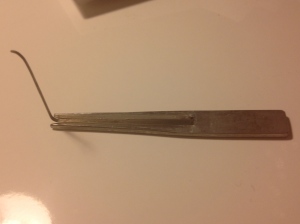The demir-khomus,also known as the “jew’s harp” is a small, wind instrument of Turkic origin played in Yakutiya, Altay, Tuva, Khakassia, and Central Asia. In Russian, people call it bargan. The demir-khomus is lamellophone instrument, meaning that most of it sounds come from a thin metal tongue or reed, which is attached to a metal frame that is held against the performer’s teeth and plucked with the finger to produce a note. By changing the shape of the mouth, blowing air, and moving the tongue, a person can make different melodies. The khomus is a one-pitch instrument, but it can be played in myriad ways. Many musicians can also throat sing while playing the khomus.
The word “demir,” which means “steel” in Turkish, describes the material of the khomus. Tuvans use different type of khomuses such as the “cha-khomus,” which consists of an arrow and bow that has an attached mouthpiece. The musician is supposed to produce the sound by tapping on the bow’s string with the arrow and exhaling through mouthpiece. There is also the yash-khomus (wooden khomus), the kulzun-khomus (bamboo khomus), and the sook-khomus, which is made out of bone. One of the oldest khomuses was found in 1994 at an archeological dig in Novokuznetsk, a town in Russia. Ancient Turkic people used to bury people with their most prized possessions.
Above: Cha-Khomus.
To play the demir-khomus is to experiment. After learning to use the instrument properly, people may get bored easily; that is why one must be a lover of weird sounds and effects in order to play the khomus. Each khomus player has his or her distinctive sound. According to shaman beliefs, this is because the sound of the khomus reflects the soul of the person who plays it. The khomus is not only a musical instrument; it is a tool that enables communication with the spirit world.
Before I came to Abakan, one of my first associations with the Siberian steppe was the unearthly, vagabond sound of the khomus. In Abakan, I would often attend concerts and listen to traditional Khakas music, which was usually accompanied by the khomus. When I attended shaman rituals, I also to see the instrument performing a religious function. I wanted to buy one, but every time I went to the store in Abakan to buy a khomus and saw how expensive they were, I would change my mind and sadly shuffle away.
I first bought my first demir- khomus at the Tuvan National Museum for 700 rubles. The lady who sold me the khomus happened to be a professional khomus musician and wife of person who manufactures them. Reluctant, but curious I let the lady put my newly bought khomus in her mouth. How else could she show me? So she took out the instrument from her mouth and handed it to me. I wiped of the saliva from the back of the little metal frame and began to play. In five minutes I progressed from a clicking sound to a cartoonish, vibration sound.
“You did it!” The lady seemed surprised.
Feeling like a prodigy, I walked back from the museum, plucking on my khomus. Soon, I was able to make vibrato sounds and vocalize “i” and “e.” I practiced for almost two hours until I finally realized that I was not going to be able to play anything interesting. More and more I felt like I was playing a kazoo. I decided that taking at least a few lessons could be a good idea.
I went to the Tuvan Cultural Center to eat and possibly enquire about khomus lesson. Judging by his Tuvan, ponytail hairstyle and the instrument leaning on the table next to him, I could tell that the man who was sitting across from me worked as a musician at the cultural center. When I finished eating I approached him and asked him if he knew about khomus lessons. He said that he did not know, but that he could give me the lessons himself. I ran back to my dorm, grabbed my khomus, and went back to begin my first lesson with Aydyn.
Aydyn is a professional throat singer, just like his father. In Tuvan culture,the talent of throat singing is hereditary.In addition to throat singing, he also plays pretty much every tuvan instrument and belongs to the Tuvan National Orchestra. When I heard Aydyn play the khomus, I realized that khomus did not resemble a kazoo. I got jam with Aydyn. He throat sand and played the guitar while I played the khomus It is possible to play notes, make melodies, and even play sound effects. Aydyn could imitate the sound of a galloping horse by muffling the sound and plucking the reed with rhythmic alternating motions. Because I was told that the instrument might break if you pull the reed forward, I was afraid of doing alternating motions.
“You have to do it more boldy,” Aydyn told. “Let go.”
My khomus lessons with Aydyn reminded me taking guitar classes when I was fifteen. The instructor kept telling me to “loosen up” аnd feel the music. For some reason, this was always my biggest obstacle when it came to playing instruments, even now, when I was playing a one-pitch instrument.
I walked back to my dormitory after the lesson, feeling like the shittiest khomus player in Siberia. A few hours later I began to feel the beginnings of a nasty cold.
So, in the end, all I got from my lessons was a cold and a reminder of my need to “loosen up.”

